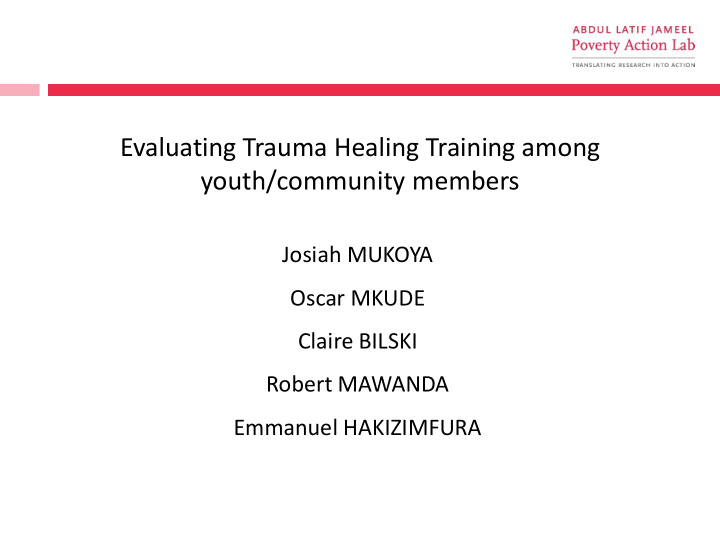



Evaluating Trauma Healing Training among youth/community members Josiah MUKOYA Oscar MKUDE Claire BILSKI Robert MAWANDA Emmanuel HAKIZIMFURA
Background • Conflict affected communities living along the borders of Kenya with Uganda, South Sudan, Ethiopia and Somalia. • Many people suffering from Trauma due to violence • Train 40 TOTs (20F and 20M) in Trauma healing • One day trauma healing training session per week for 6 weeks targeting traumatized at risk youth/community members along the border lines. • 40 TOTs help youth/community members
Theory of Change Data to be collected Trainers are trained and organizing healing Information of the intervention in the Inputs trainers and where communities training took place and its duration Individuals are getting Number of sessions Outputs help organized, duration Improved psychological health Outcomes Less behavioural violence Improved social Impact skills Improved livelihood options
Evaluation Questions and Outcomes Indicators to assess change: • Improved psychological health/ level of trauma - E.g. stress level: cortisol level (biomarkers: saliva/blood tests) – to be continued… • Improved social skills - Cooperation with neighbours: e.g. no. individuals spoken with outside the community in the past 7 days • Decrease in violent behaviours - Opinion questions, e.g. It is generally wrong to get into physical fights with others (it’s really wrong/ it’s sort of wrong/ i t’s sort of OK/ it’s perfectly OK…) - Actual violence questions – general/domestic
Cont. Eval. Questions and Outcomes • For example, randomly pick who will have 3 questions/4 questions – calculate difference: • Without - I went to a club - I ate in a restaurant - I got married • With - I went to a club - I ate in a restaurant - I got married - I engaged in violent behaviour
Cont: Eval. Questions and Outcomes • Improved livelihoods - Income/assets: – Asset ownership - Access to water/land, etc. - Income/ groups savings/ bank account - Education: – Education level - Years spent at school - Highest degree - Health: – No. health facility visits in past 30 days - Vaccinations
Evaluation Design • Cluster randomization - Unit = village level - Basic lottery - Stratify by region
Data and Sample Size • Data source - Baseline survey (balance checks) - Mid-line survey - End-line survey • Power calculation – Conservative effect size (0.20); two variations of ICC (0.10 and 0.20)
Data and Sample Size # # Total Attrition Total sample Effect size Communities Participants/ number of ICC rate size (SD) (clusters) Community beneficiaries 225 (1/2 C; ½ 1330 5 565 15% 0.20 0.10 (1/2 C; ½ T) T) 290 (1/2 C; ½ 1706 5 725 15% 0.20 0.20 (1/2 C; ½ T) T)
Power calculation
Assumptions • Attrition will be at the minimal • Economic and business environment among the different boarders will be conducive. • The government, civil society and private sector institutions and actors will demonstrate continuous commitment to the program • Continued willingness of community and beneficiaries to participate in the program • Policy makers at local and national levels are willing to use evidence gathered to change or review laws and policies
Potential challenges • A lot of different outcome variables (same positive impact on all?) • Stretch between intervention and some of the outcome variables?
Potential challenges The time lapse between training and evaluation The timing of when to conduct the impact after the training has a great influence on the results. Too soon a time will not allow for the effects of the training to have been felt, however, it makes it easy to trace the trainees. Too long a time will allow for the effect of the training to be visible on the business. A long time lag however makes it difficult to find the trainees.
Results • Why (and for whom) they would be useful. • How would you disseminate them.
Recommend
More recommend